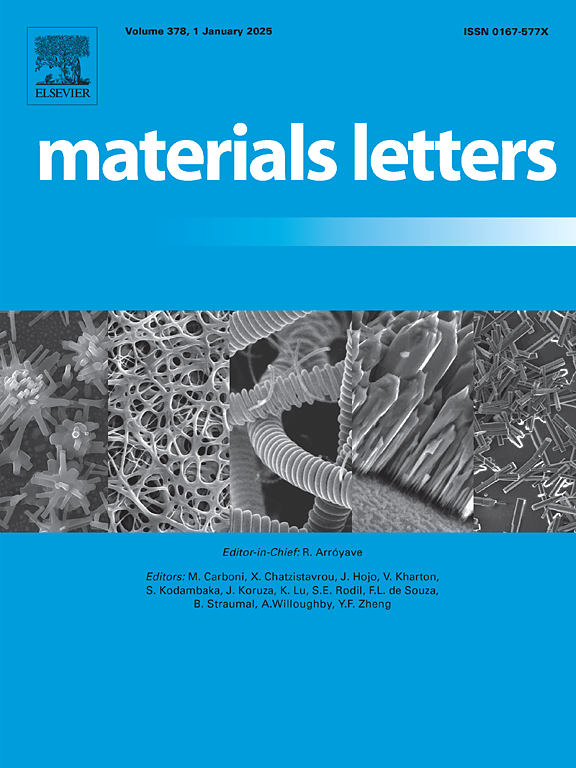羧基部分对1,1′-二苯基-4,4′-联吡啶盐电致变色性能的影响
IF 2.7
4区 材料科学
Q3 MATERIALS SCIENCE, MULTIDISCIPLINARY
引用次数: 0
摘要
Viologen具有优异的综合电致变色性能,包括光学对比度、显色效率、响应时间和循环稳定性。本文通过在苄基上引入羧基部分,研究了1,1′-双(4-羧基-苄基)-4,4′-二溴联吡啶的电致变色性质。将该化合物与苄基紫胶溶液夹在电致变色器件中,比较了它们的电致变色性能。我们发现,与没有这个基团的131.6 cm2/C相比,羧基部分促进了紫苄基的显色效率提高到165.9 cm2/C。羧基产物的光学对比度ΔT可达74.6%,而无羧基产物的光学对比度为61.3%。在607 nm下循环1000次后,羧基产物的光学对比度保持在初始值的93.3%,高于未经改性的69.8%,表明羧基部分增强了循环稳定性。本研究表明,羧基能提高紫红苄基的整体电致变色性能。本文章由计算机程序翻译,如有差异,请以英文原文为准。
Effect of carboxyl moiety on the electrochromic properties of 1,1′-dibenzyl-4,4′-bipyridinium salt
Viologen exhibits excellent comprehensive electrochromic properties including optical contrast, coloration efficiency, response time and cycling stability. Herein, the electrochromic properties of 1,1′-bis(4-carboxyl-benzyl)-4,4′-bipyridinium dibromide were examined via introducing carboxyl moiety onto benzyl group. The solutions of this compound and benzyl viologen were sandwiched into electrochromic devices and their electrochromic properties were compared. We found that carboxylic moiety facilitates benzyl viologen to exhibit increased coloration efficiency up to 165.9 cm2/C with comparison to that of 131.6 cm2/C without this group. The optical contrast, ΔT, reaches up to 74.6 % for the carboxylic product while that of 61.3 % was obtained without this group. The optical contrast of carboxylic product monitored at 607 nm for 1000 cycles retained 93.3 % of its initial value, which is larger than that of 69.8 % without modification, indicating that the cycling stability is enhanced by carboxylic moiety. This work demonstrated that carboxylic group can improve the overall electrochromic performance of benzyl viologen.
求助全文
通过发布文献求助,成功后即可免费获取论文全文。
去求助
来源期刊

Materials Letters
工程技术-材料科学:综合
CiteScore
5.60
自引率
3.30%
发文量
1948
审稿时长
50 days
期刊介绍:
Materials Letters has an open access mirror journal Materials Letters: X, sharing the same aims and scope, editorial team, submission system and rigorous peer review.
Materials Letters is dedicated to publishing novel, cutting edge reports of broad interest to the materials community. The journal provides a forum for materials scientists and engineers, physicists, and chemists to rapidly communicate on the most important topics in the field of materials.
Contributions include, but are not limited to, a variety of topics such as:
• Materials - Metals and alloys, amorphous solids, ceramics, composites, polymers, semiconductors
• Applications - Structural, opto-electronic, magnetic, medical, MEMS, sensors, smart
• Characterization - Analytical, microscopy, scanning probes, nanoscopic, optical, electrical, magnetic, acoustic, spectroscopic, diffraction
• Novel Materials - Micro and nanostructures (nanowires, nanotubes, nanoparticles), nanocomposites, thin films, superlattices, quantum dots.
• Processing - Crystal growth, thin film processing, sol-gel processing, mechanical processing, assembly, nanocrystalline processing.
• Properties - Mechanical, magnetic, optical, electrical, ferroelectric, thermal, interfacial, transport, thermodynamic
• Synthesis - Quenching, solid state, solidification, solution synthesis, vapor deposition, high pressure, explosive
 求助内容:
求助内容: 应助结果提醒方式:
应助结果提醒方式:


